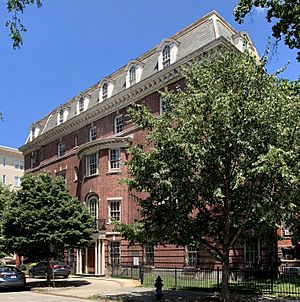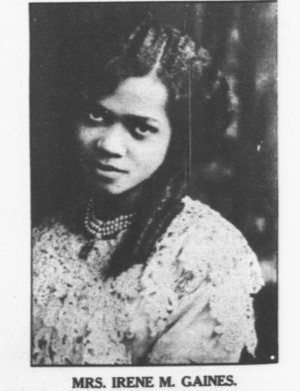National Association of Colored Women's Clubs facts for kids
The National Association of Colored Women's Clubs (NACWC) is an important American organization. It was created in July 1896 in Washington, D.C., USA. This happened when several groups, like the National Federation of Afro-American Women and the Colored Women's League, joined together.
The idea came from Josephine St. Pierre Ruffin. From 1896 to 1904, it was called the National Association of Colored Women (NACW). Their motto was "Lifting as we climb." This meant they wanted to show the world that their goals were the same as all good women who wanted to improve. In 1904, the organization officially became the National Association of Colored Women's Clubs (NACWC).
Contents
History of the NACWC

The National Association of Colored Women, which later became the NACWC, started in Washington, D.C., on July 21, 1896. Their first big meeting was held at the Nineteenth Street Baptist Church. Many groups joined this meeting, including the National Federation of Afro-American Women and the Woman's Era Club.
These groups and others from across the country came together to form the NACW. The organization worked hard to help all African-American people. They focused on important issues like civil rights, fairness, and ending unfair laws. They also supported women's right to vote and fought against harmful practices like lynching and Jim Crow laws.
Why the NACWC Was Started
Two key leaders of the NACWC were Josephine St. Pierre Ruffin and Mary Church Terrell. They helped organize women's clubs at the 1896 meeting. They wanted to fight against unfair and negative ideas about Black women. They stood up against a letter that called Black women bad names. Mrs. Booker T. Washington, Margaret Murray Washington, helped lead this important meeting.
Many famous women helped start the NACWC. These included Harriet Tubman, Margaret Murray Washington, Frances E. W. Harper, Ida Bell Wells-Barnett, Victoria Earle Matthews, Josephine Silone Yates, and Mary Church Terrell.
What the NACWC Wanted to Achieve
In its first year, the NACWC focused on many problems that made it hard for Black people to succeed. They wanted to fix issues like unfair prison systems and laws that separated people based on race. They also worked to help mothers and children, and to improve living conditions in poor areas. They wanted to create homes for working people and help those who had lost their way.
Over the next ten years, the NACWC became very active. They supported women getting the right to vote and fought against lynching. They also worked to end Jim Crow laws, which enforced racial segregation. The organization also led efforts to make education better and to care for children and older people.
The number of members grew a lot. In 1897, there were 5,000 members. By 1924, there were 100,000 members! The membership decreased during the Great Depression, a time when many people faced economic hardship.
Important Leaders of the NACWC
Josephine St. Pierre Ruffin and Mary Church Terrell were very important to the National Association of Colored Women. Their hard work helped the NACWC become the most well-known organization during the African-American Woman Suffrage Movement. This movement fought for Black women's right to vote.
Both women were well-educated and came from families who had achieved financial success. Josephine St. Pierre Ruffin used some of her own money to start Woman’s Era. This was the first magazine published by and for African-American women. This magazine helped connect Black women and create a community for NACWC members. Mary Church Terrell was also a strong leader. She led the fight in Washington, D.C., against segregation in restaurants. She even won a court case that helped end segregation there.
NACWC Goals
The NACWC has several important goals:
- To improve the lives of women and children in terms of money, good behavior, religion, and social connections.
- To protect the rights of women and children.
- To make homes and families stronger and better.
- To use their influence to make sure all citizens have civil and political rights.
- To help educate women and children through effective programs.
- To help African-American families achieve their highest potential.
- To work well with the organization's male helpers.
- To help different races understand each other, so that fairness and kindness can exist among all people.
Presidents of the NACWC
Many inspiring women have led the NACWC throughout its history. Here are some of the early presidents:
- Mary Church Terrell – 1st President (1896–1900)
- Josephine Silone Yates – 2nd President (1900–1904)
- Lucy Thurman – 3rd President (1904–1908)
- Elizabeth Carter Brooks – 4th President (1908–1912)
- Margaret Murray Washington – 5th President (1912–1916)
- Mary B. Talbert – 6th President (1916–1920)
- Miss Hallie Q. Brown – 7th President (1920–1924)
- Mary McLeod Bethune – 8th President (1924–1928)
Many other dedicated women have served as president, continuing the important work of the organization. The current president, as of 2024, is Denise E. Williams.
NACWC Conventions
The NACWC has held many conventions, which are large meetings, over the years. These meetings bring members together from different states to discuss important issues and plan their work. They have held conventions in many cities across the United States, including Nashville, Chicago, New York, and Washington, D.C. These regular gatherings help the organization stay strong and focused on its goals.
Other Important Clubs
The NACWC works with many other clubs across the country. These are called "affiliates" and include:
- California State Federation of Colored Women's Clubs
- Empire State Federation of Women's Clubs
- Indiana State Federation of Colored Women's Clubs
- Iowa Federation of Colored Women's Clubs
- Mississippi State Federation of Colored Women’s Clubs
- Northeastern Federation of Colored Women's Clubs
- Oklahoma Federation of Colored Women's Clubs
- South Carolina Federation of Colored Women's Clubs
- Texas Association of Women's Clubs
See also
- African-American women's suffrage movement
- Black feminism
- The First National Conference of the Colored Women of America


